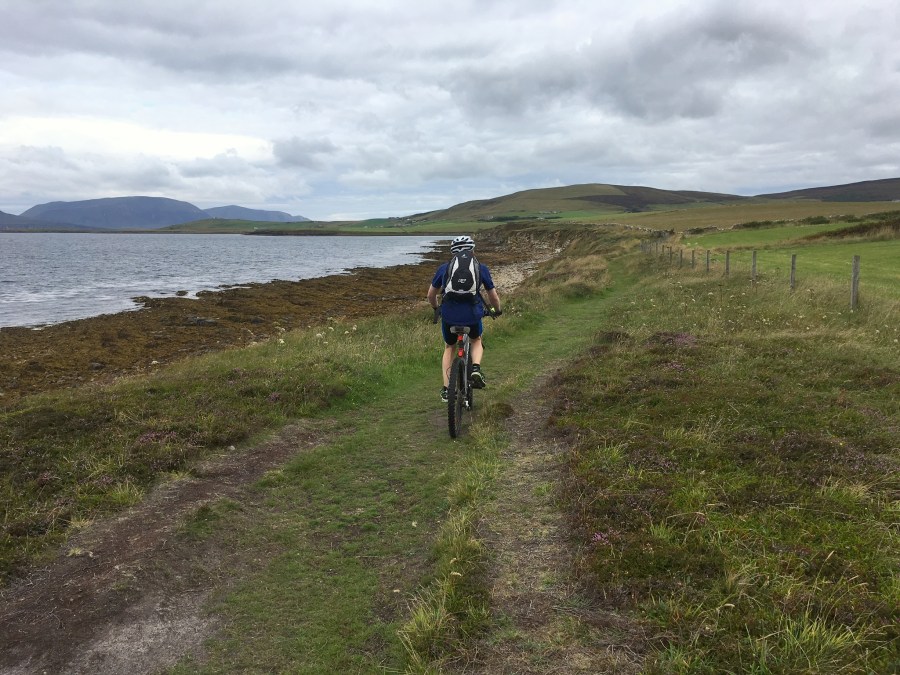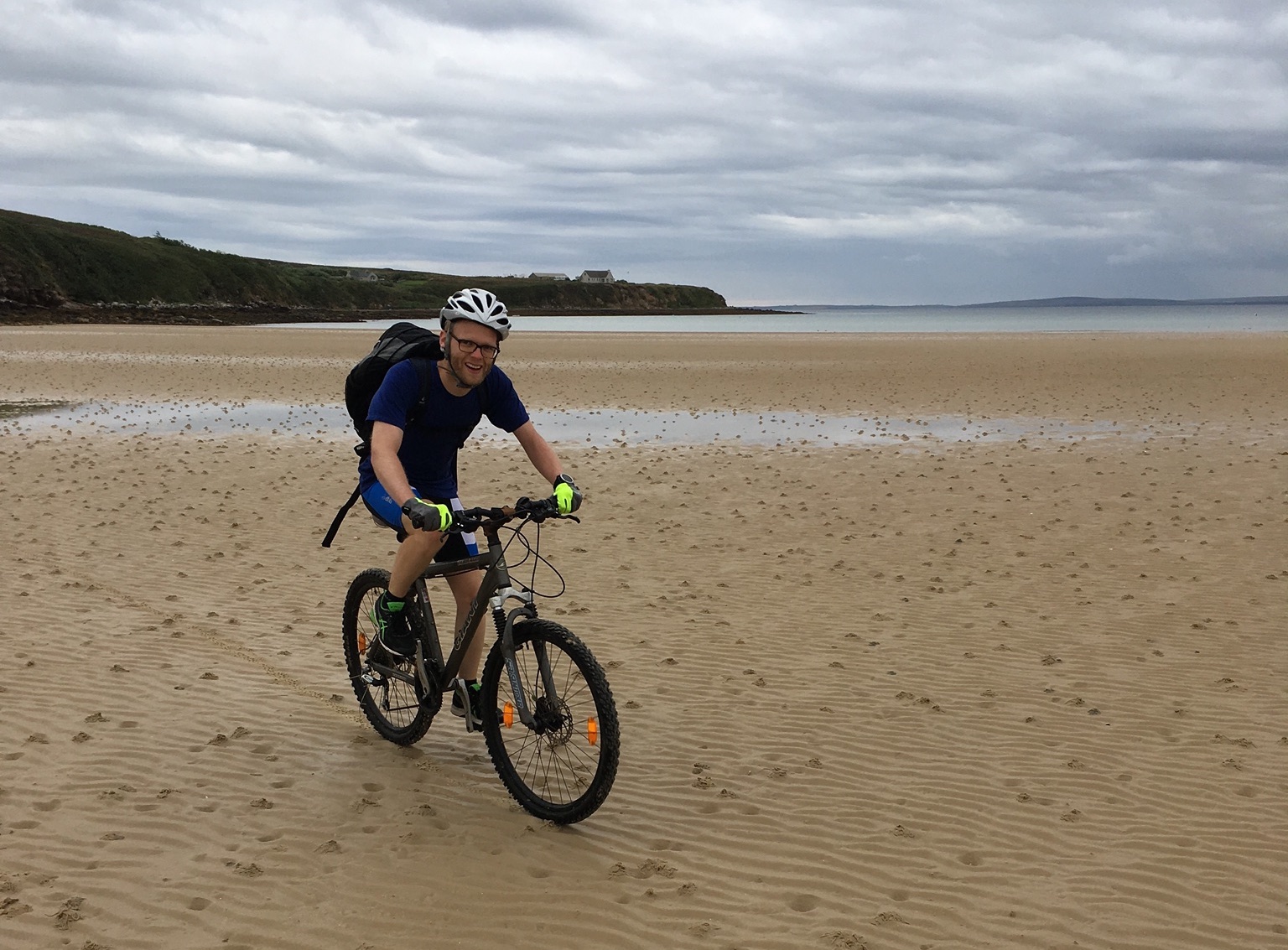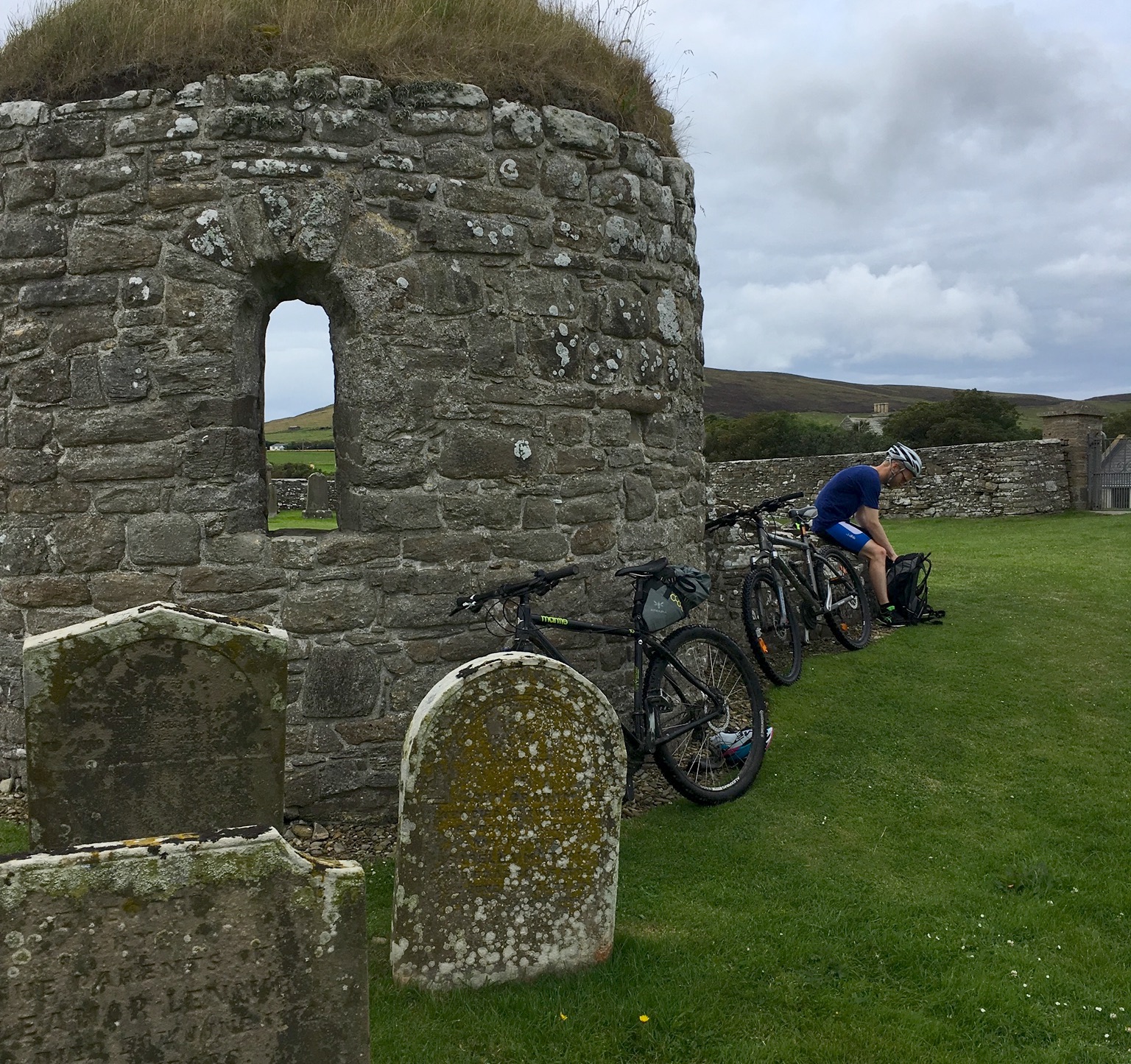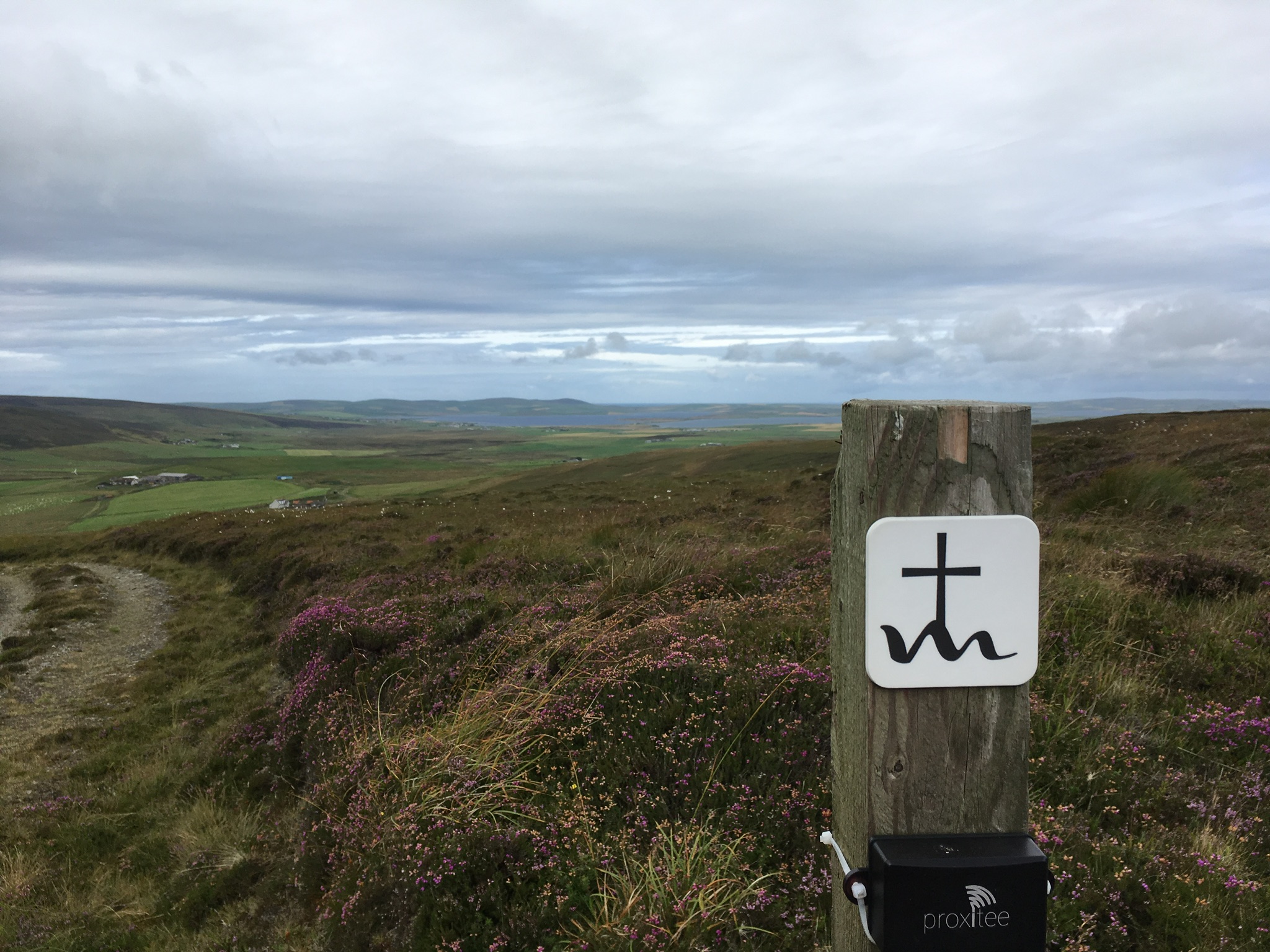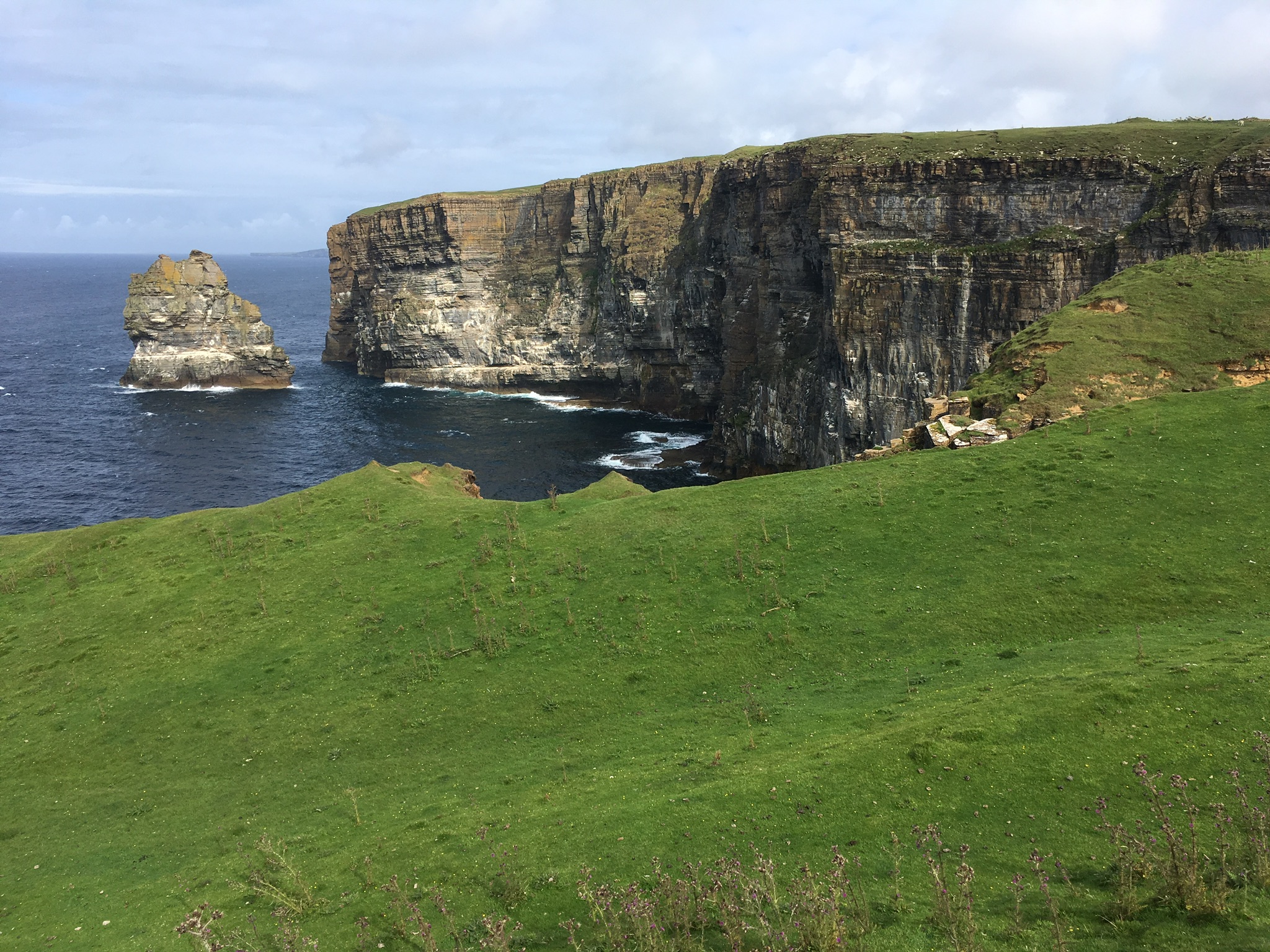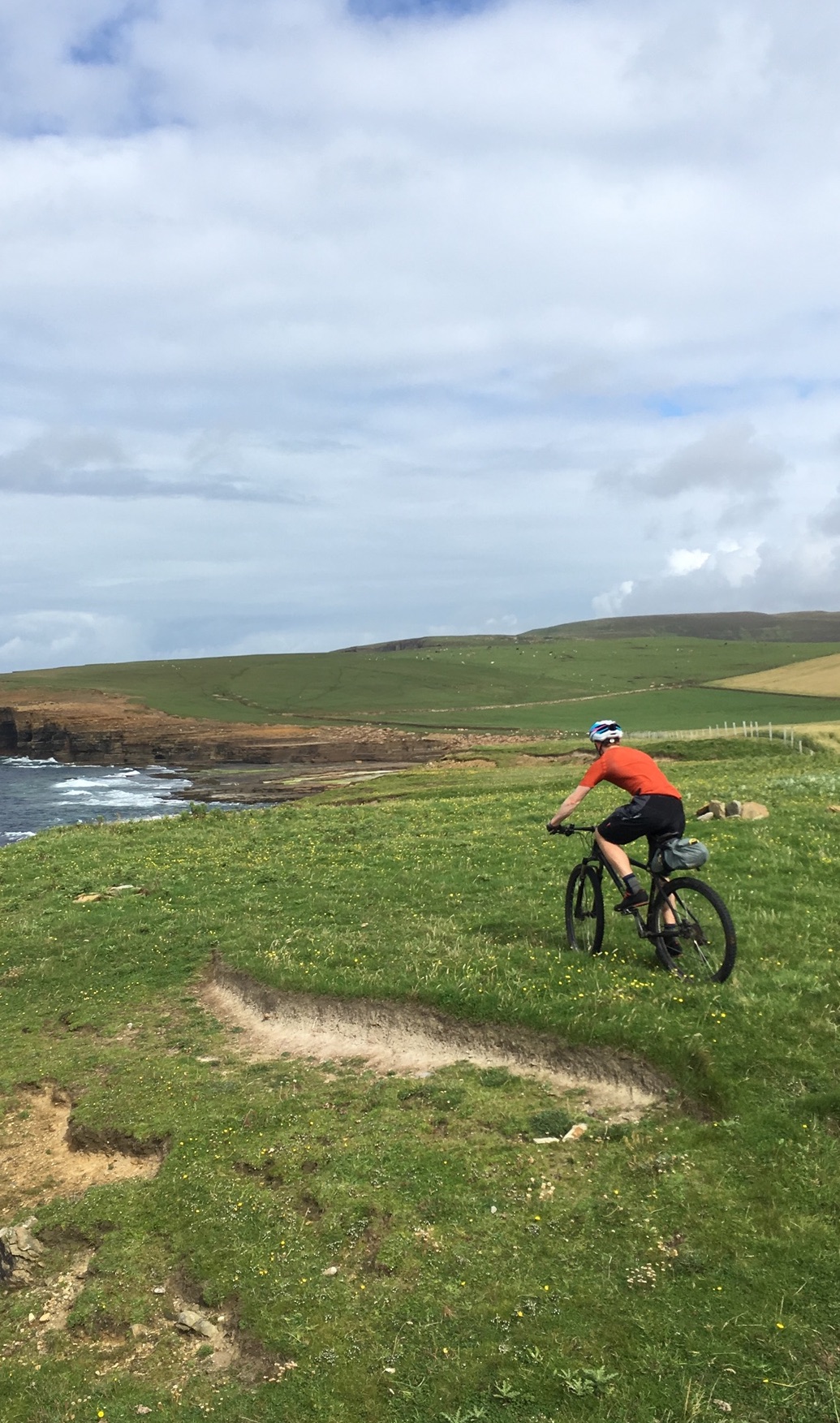Adam Boggon and Jack Cunningham set out to ride the St Magnus Way on mountain bikes, and find a wilder side to Orkney than they had expected.
Other digital features by Adam Boggon
- Confusion in East Africa
- Saga of Magnus – an Orkney journey
- Down to the river – mucking about in boats in the Borders
- Snowbound
Saga of Magnus – an Orkney Journey
by Adam Boggon
I have sheltered from rain beneath the arched entrance to St Magnus cathedral, Orkney. Eight hundred years of wind and salt have eaten into the red sandstone, gnawed deep crenellations into the pillars, filed corners and bellies of stones. It is not a process of decay but of burnishing, whereby the ancient edifice stays gold.
I had worked in Kirkwall’s hospital for six months and was shortly to depart. The islands had been full of surprises and quiet wonderful things and I could not leave without paying reverence. A pilgrimage way passes through the West Mainland: 55 miles charting the journey of St Magnus’s body from the site of his martyrdom on Egilsay to his burial place in Kirkwall. Surely the ground could be covered in one day on a mountain bike? This would suit my purpose.
For companion I had Jack Cunningham — flatmate, colleague, and my one close friend in Orkney. He was training for a half-ironman and is a capable open-water swimmer. I was confident he would endure. He hadn’t handled a mountain bike much and didn’t own one. Secondary issues.
He tried to hire one from the Kirkwall cycling shop but was informed that no, they did not rent mountain bikes, and that in any case the St Magnus Way could not be cycled in a single day. I explained to Jack a favourite refrain of my university flatmates (usually crowed tipsily in an appalling southern drawl): “They said it couldn’t be done, so we did it!” I was pleased to hear the gauntlet had been thrown.
Jack subsequently received six offers of bicycles after entering a plea to the online forum ‘Orkney Merkit Place’. First he took possession of an all-black double-suspension downhill bike which may have formed part of the plans for D-Day. This heavyweight was clearly a non-starter so I was relieved when he borrowed a much nimbler hardtail alternative from the husband of an A&E nurse.
“Being in the water feels like a right way to be present in the islands, which are themselves as much water as land and light and grass. Afterward your body tingles”
Late summer in Orkney the sky is light before 5.30am. We sat with bowls of porridge as light trickled into the Brasserie — our sitting room in the accommodation block. On moving to Kirkwall in February few rooms had borne less resemblance to the interior of a French restaurant: bare white walls, a ruckle of broken chairs, smell of stale linen. Now, with fresh flowers, a selection of maps and whisky, postcards from the Prado Museum on the wall and a small sign advertising ‘Grande Brasserie Pignoux-Bourges’ Jack had sourced from a woman in Ukraine, we had a temporary home for which we felt great affection.
The restful ambience of the Brasserie did not endure beyond the first few miles of the journey. We set off from Graham House at 6.30am to join the snaking trail south-west along the edge of Scapa Flow. Within ten minutes Jack had vaulted over his handlebars and fallen several metres down a grassy slope. He was bashful but unhurt. I wondered to myself: have I made a bad plan?
The trail was stupendously overgrown, invisible through shoulder-high grass. In a low gear if you kept spinning your legs and just believed there was a path to be followed, you could just about keep going. I realised that path-making is conjectural: you can declare ‘here is a trail’, but the land reserves the right to deny it.
A pod of seals lay upon the shore. They flubbed about on their tummies and flipped into the bay — all oil and hide. In island mythology, Selkies are seal-folk who shed their skin on land and take human form. Orkney tales are full of their dancing and enchantment. Early in the morning, these myths become believable.
We waded through grass and thorn to Waulkmill Bay, where a long tidal beach digs into the West Mainland. I have swum in the sea there, as I have taken to swimming all over the islands — near the Gloup at Deerness, Rackwick in Hoy, at Inganess and Yesnaby. Being in the water feels like a right way to be present in the islands, which are themselves as much water as land and light and grass. Afterward your body tingles.
Today we kept riding over the sand towards Orphir. Near here, at the Hall of Clestrain, lived John Rae. Rae was a doctor and Arctic Explorer who from 1846–1854 trekked 13,000 miles through the Canadian Arctic, mapped 1,800 miles of coastline, discovered the grizzly fate of John Franklin’s expedition and found the last section of the Northwest Passage. An Orcadian by birth and upbringing, he preferred the company of Cree, Hare and Dogrib Indians, with whom he went hunting and from whom he adopted means of survival and transportation: flat sledges, moccasins and snowshoes. He travelled light and crossed unfrozen reaches in an India-rubber cloth boat. In the Victorian era, he was among the first to respect, learn from and work with indigenous Arctic communities, and the success of his explorations were due in large part to this. In St Magnus Cathedral his effigy is carved in Portland stone. Rae lies sleeping on his back wrapped in a buffalo skin robe with his gun and a book by his side.
After Waulkmill I lost track of the little white squares with black crosses that mark the direction of the St Magnus Way. I followed my nose and bustled west. Fifteen minutes later, after crossing the sixth gate in a mile, I admitted to Jack that route selection had become speculative.
Sure enough, we shortly came into a field containing forty cows. There were calves. They all looked a bit jumpy. Jack held back: “I’m wary of these. I had a lecturer who was trampled to death.”
We turned round and found an alternative farm track to Orphir.
The St Magnus Way avoids Orkney’s main neolithic sites at Scara Brae, Stenness and Maeshowe. This was fine by me. There is an undeniable wonder in these ancient tombs and dwellings but my view on archaeology approximates that of my 12-year-old cousin Hannah: “Some people must really love dust.”
To me, the more interesting part of Orkney’s history is the nearly 500 years in which the islands were part of the Norse empire. We know their names: Rongvald, Siggurd, Hakon. Through their written source, the Orkneyinga saga, we know how they lived. The saga, a 13-century history of the Earls of Orkney, relates tangled genealogies, marauding heroes and fluid kinship groups. The thread woven is of a generationally recurring struggle for control over the Earldom: two or three powerful individuals batter around island and sea, making and breaking pacts with one another. In the end someone usually winds up trapped and burned inside their own barn.
Their ethic is encapsulated by Svein Asleifsson:
Winter he would spend at home on Gairsay, where he entertained some eighty men at his own expense… In the spring he had more than enough to occupy him, with a great deal of seed to sow which he saw to carefully himself. Then when that job was done, he would go off plundering in the Hebrides and in Ireland on what he called his ‘spring-trip’, then back home just after mid-summer, where he stayed till the cornfields had been reaped and the grain was safely in. After that he would go off raiding again, and never came back till the first month of winter was ended. This he used to call his ‘autumn-trip.’
Svein comes to a bad end eventually — trapped and slain in a pit dug inside the city walls of Dublin by the Irishmen he had come to pillage. But by then he had established a reputation as the most irascible and mischievous of all the sons of Orkney. As he says to Earl Rongvald before his final foray: “Hard to tell which comes first, old fellow, death or glory.”
“Eventually I broke through to the other side and picked snarls of shrubbery out of my spokes and derailleur. Five or ten minutes passed before Jack appeared, his countenance blanched with dread”
We made it at last to the Earl’s Bu at Orphir, site of yet another burning in the Orkneyinga saga. It had taken us three hours to hack through the barely navigable reaches from Kirkwall and we lumped down on the ruins of an early kirk. This had the potential to become a very long day.
The trail improved as we skirted around Ward Hill and over the Hill of Lyradale in time for elevenses at Leigh’s food van in Finstown. From there the way proceeded through Binscarth Wood to Refuge Corner before a section on the road to Dounby. This patch of Orkney is green and fertile: all but the ancient stones and brochs are given over to farmers — who till the earth and are occasionally gored by livestock.
Leaving Dounby, the markers led us past a rumple of farmhouses along a narrow track that culminated in an 800m section marked as an entirely blank space on my Ordnance Survey map. It was an abysmal thicket. The undergrowth reared up and plucked me off my bike, scattering me into the barbed-wire fence. Occasional white squares appeared on fence posts. They winked at us, as if to say “yes, we wondered when you would come.”
Eventually I broke through to the other side and picked snarls of shrubbery out of my spokes and derailleur. Five or ten minutes passed before Jack appeared, his countenance blanched with dread. I recognised his expression from a picture on the wall of the Brasserie: The Half-Drowned Dog by Goya.
We returned to the Birsay road and cycled through the discreetly spelled village of Twatt. In a tearoom we met one of the surgeons who advised that part of the final section was best avoided by beast or man, despite her husband’s efforts to clear the way: “Peter’s been out strimming but he’s hardly made a dent in it. It’s basically impassable.” After our encounter with the uncharted region near Dounby we needed little encouragement to heed her advice.
On the clifftop trail from Evie to Birsay the margin for error was at times vanishingly small. In one moment of absent-mindedness I came within a reflex of pitching off a 30m face.
The St Magnus Trust suggest themes for mediation as you travel: Explore Grief, Explore Change, Explore Forgiveness. As we hauled, pushed, swore at and carried our bikes up and down the deep gouges in the land near Skiba Geo I mused on another theme: Explore Belligerence.
Here puffins and fulmar nest side by side. Two more dissimilar birds are scarcely imaginable. Fulmar are of the same order of species as the albatross. They possess economy of flight: every manipulation of wingtip is precise, faultless as they wheel in strong winds. To see a puffin in flight by contrast is to witness winged panic. If puffins have thoughts, these must be restricted to ‘Oh my gosh! Oh my gosh! Oh my gosh!’ Just before they crash into the sea they seem to remember how to do it.
“To see a puffin in flight by contrast is to witness winged panic. If puffins have thoughts, these must be restricted to ‘Oh my gosh! Oh my gosh! Oh my gosh!’”
From the northern lip of the West Mainland you see the islands of Westray, Rousay, Eynhallow and Wyre. In Westray, the cabin of a Norwegian tall boat shipwrecked in 1879 was salvaged by the islanders. Hauled ashore, it served as a dwelling place for over a hundred years before Edwin Rendall, a local artist, mounted it on guttering tubes filled with cement, rolled it to his favourite spot and built his gallery around it.
Rousay is home to fewer artists but the population make up for this by being heavily armed. One of the hospital pharmacists, Ellen, is special constable for the island and reminded me that Orkney life is not all tranquility and weaving:
“So this man was ravin’ that this other chap’d been having an affair with his wife. He was pointing a shotgun at his chest and said that once he’d killed him he’d shoot his wife and anyone else on the island who’d ever pissed him off. If he was going down for one shooting he may as well settle all his other scores tonight.”
Ellen is burly, friendly and unassuming. She’d never seen anything like this. She responded instinctively:
“I nodded to the guy with the gun in his stomach, he grabbed the barrel and I tackled the armed man to the ground. We chucked the shotgun into the bushes. He was a big man and I didn’t know what to do so I got some baling string, tied him up and sat on his chest for half an hour. Eventually he calmed down so I handcuffed him to a chair and talked to him for three and a half hours until the police arrived. There were four police cars and eight armed officers from Inverness. They were surprised to find everything had settled down.”
I asked what happened to the assailant.
“He got five years imprisonment and a lifetime ban from Orkney: the ultimate sanction.”
Some approach islands naively. As though life will be simpler. As if fear and loathing do not inhabit remote places. Some move to islands to escape their past, begin anew, find equanimity. Often they discover what C.P. Cavafy knew:
You shall not find new places; other seas
you shall not find. This place shall follow you.
And you shall walk the same familiar streets,
and you shall age in the same neighbourhood,
and whiten in these same houses.
We bring Laestrygonians and Cyclops (and Selkies and Stoorworm) inside us where we go — they are not displaced by land or landscape. But there are moments of reprieve. As I pushed into the seventh hour of exertion, I was ataraxic: skin alive, breath alive, hungry for each movement.
Riding the last road to Evie the birds all took flight – geese, curlew, oystercatcher. We’d travelled a long way by road, track, clifftop, sheeptrack, woodland, shoreline, sand. I held my right arm ahead of me like a lance. I made a joyful sound.
Afterwards, Jack and I walked into the sea at Evie and let the cold waters fold around us. We were sea-battered, wind-battered, marrow-tired, full of light. I recalled a line of J.D. Salinger’s: “Seymour once said that all we do our whole lives is go from one piece of Holy Ground to the next. Is he ever wrong.”

